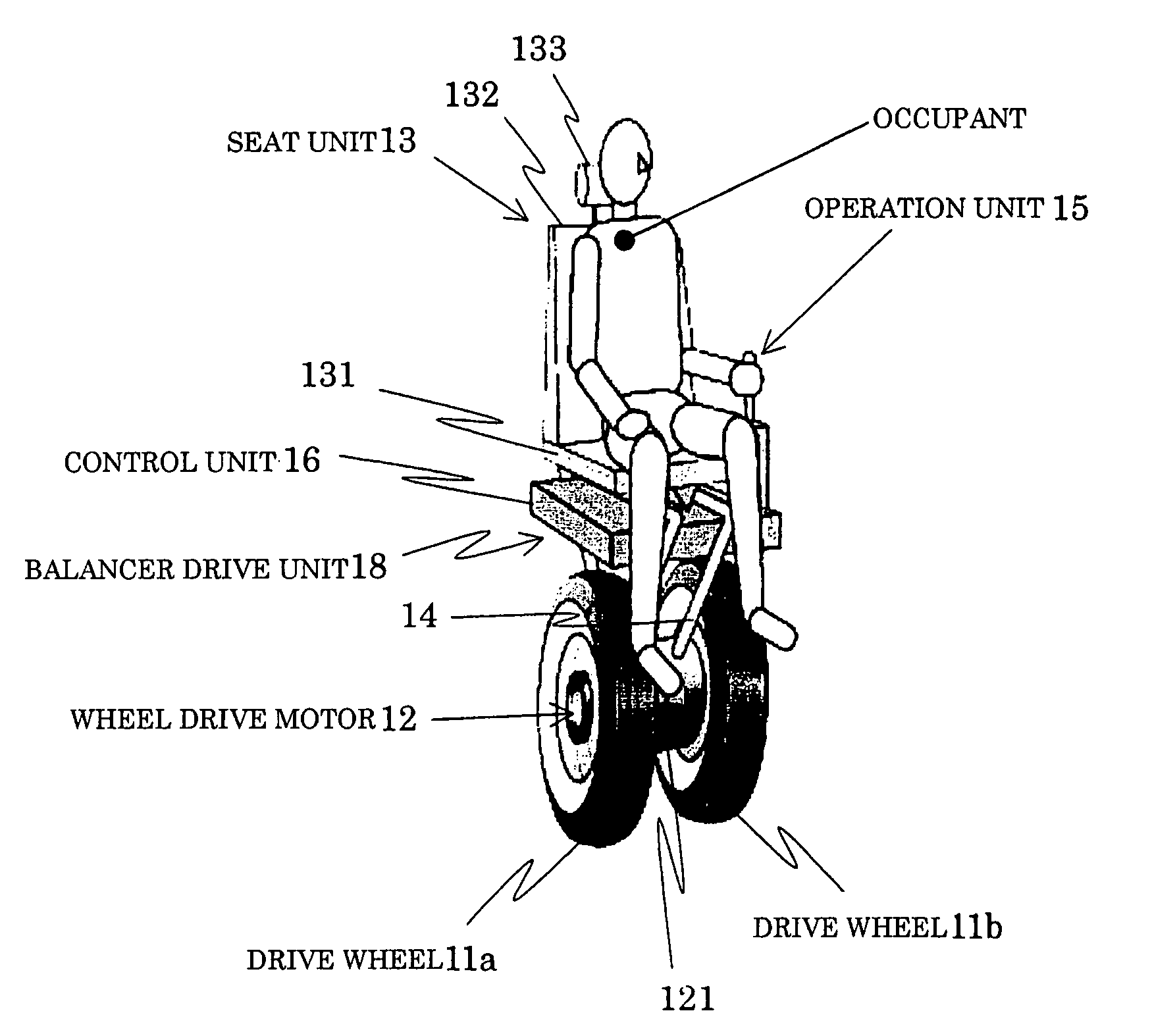Vehicle
a technology of inverted pendulum and attitude control, which is applied in the field of vehicle attitude control, can solve the problems of complicated attitude control, failure to take a balance, and interference with the improvement of fuel efficiency, so as to simplify the attitude control, improve performance, and reduce the size of the vehicle
- Summary
- Abstract
- Description
- Claims
- Application Information
AI Technical Summary
Benefits of technology
Problems solved by technology
Method used
Image
Examples
first embodiment
(1) Outline of First Embodiment
[0086]In a first embodiment, a tilt of a seat unit (vehicle body) is detected by a gyro sensor. A torque T1 corresponding to the tilt of the seat unit is calculated based on the tilting angular acceleration. A torque T2 for negating the torque T1 to restore the seat unit in the direction opposite the tilting direction is generated by moving the balancer.
[0087]The balancer is driven with the torque T2(>T1) in the seat unit tilting direction to allow the reaction torque −T2 corresponding to the torque T2 to act on the seat unit.
[0088]The reaction torque −T2 serves to return the seat unit in the direction opposite the originally tilted direction.
[0089]As the seat unit is returned in the opposite direction, the angular acceleration when the seat unit is tilted at the side opposite the plumb line is detected by the gyro sensor. The torque T2 corresponding to the detected angular acceleration is used to move the balancer again in the opposite direction (in t...
second embodiment
(3) Outline of the Second Embodiment
[0193]In the first embodiment, the attitude control of the seat unit is executed by moving the balancer B in the direction where the occupant A tilts.
[0194]In the second embodiment, the attitude control is executed using the reaction force generated by driving the drive wheel 11 in addition to the reaction force generated by moving the balancer B.
[0195]Under the stability control (attitude control) of the occupant portion (occupant A), the reaction torque generated by moving the balancer and by adjusting the drive torque of the drive wheel 11 may be used for further stabilizing the occupant portion upon stopping / traveling / braking / turning of the vehicle.
[0196]The drive torque of the drive wheel 11 may be used for supplementing the torque generated by moving the balancer B.
[0197]More specifically, in the case where the movement torque T1 of the occupant A is equal to or smaller than a predetermined torque value, the attitude control is executed by m...
third embodiment
(5) Outline of Third Embodiment
[0221]In the first to the third embodiment, the balancer is used for the following two effects[0222](a) and (b) under the stability control (attitude control) of the occupant portion (occupant A):[0223](a) The reaction torque −T2 is allowed to act on the occupant A by moving the balancer B; and[0224](b) The gravity center is moved by positioning the balancer forward or backward with respect to the plumb line.
[0225]As the aforementioned functions may simultaneously occur as physical phenomena, the control law inevitably becomes complicated. In order to generate the reaction force of the balancer drive torque, the gravity center moves simultaneously.
[0226]In the embodiment, the control according to the second embodiment is executed when the vehicle is stopped.
[0227]When the vehicle is traveling, the balancer B is moved only for controlling the gravity center as described in the effect (b), not for generating the reaction torque.
[0228]Meanwhile, the drive...
PUM
 Login to View More
Login to View More Abstract
Description
Claims
Application Information
 Login to View More
Login to View More - R&D
- Intellectual Property
- Life Sciences
- Materials
- Tech Scout
- Unparalleled Data Quality
- Higher Quality Content
- 60% Fewer Hallucinations
Browse by: Latest US Patents, China's latest patents, Technical Efficacy Thesaurus, Application Domain, Technology Topic, Popular Technical Reports.
© 2025 PatSnap. All rights reserved.Legal|Privacy policy|Modern Slavery Act Transparency Statement|Sitemap|About US| Contact US: help@patsnap.com



